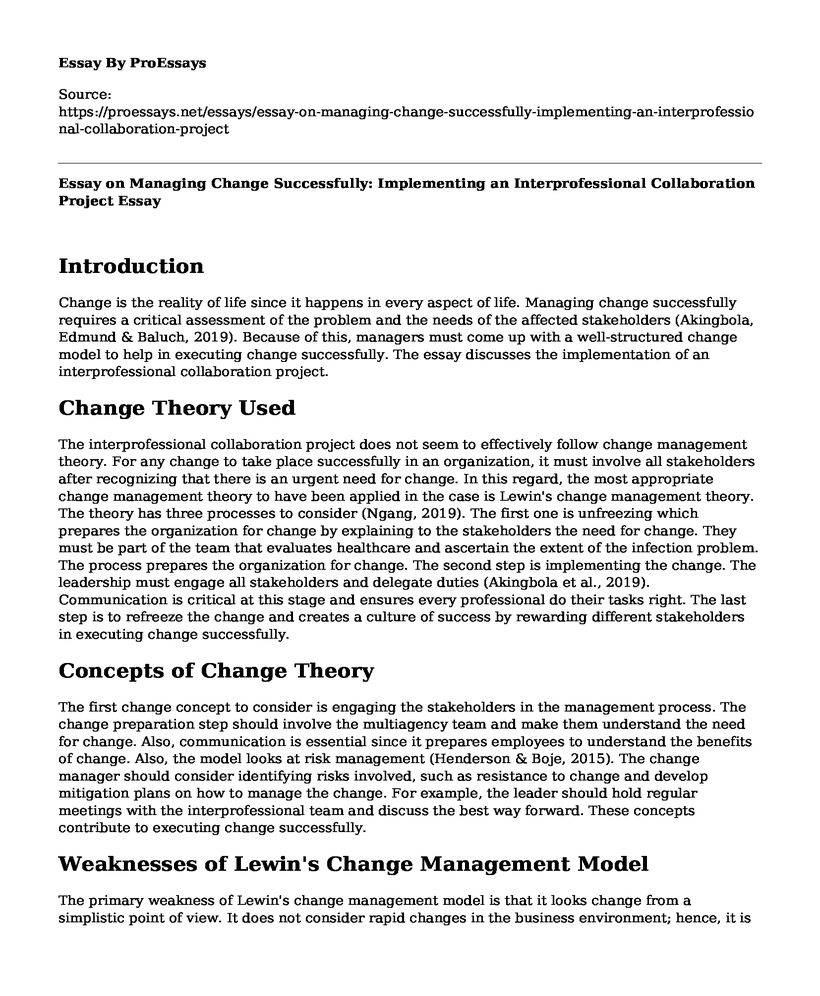Introduction
Change is the reality of life since it happens in every aspect of life. Managing change successfully requires a critical assessment of the problem and the needs of the affected stakeholders (Akingbola, Edmund & Baluch, 2019). Because of this, managers must come up with a well-structured change model to help in executing change successfully. The essay discusses the implementation of an interprofessional collaboration project.
Change Theory Used
The interprofessional collaboration project does not seem to effectively follow change management theory. For any change to take place successfully in an organization, it must involve all stakeholders after recognizing that there is an urgent need for change. In this regard, the most appropriate change management theory to have been applied in the case is Lewin's change management theory. The theory has three processes to consider (Ngang, 2019). The first one is unfreezing which prepares the organization for change by explaining to the stakeholders the need for change. They must be part of the team that evaluates healthcare and ascertain the extent of the infection problem. The process prepares the organization for change. The second step is implementing the change. The leadership must engage all stakeholders and delegate duties (Akingbola et al., 2019). Communication is critical at this stage and ensures every professional do their tasks right. The last step is to refreeze the change and creates a culture of success by rewarding different stakeholders in executing change successfully.
Concepts of Change Theory
The first change concept to consider is engaging the stakeholders in the management process. The change preparation step should involve the multiagency team and make them understand the need for change. Also, communication is essential since it prepares employees to understand the benefits of change. Also, the model looks at risk management (Henderson & Boje, 2015). The change manager should consider identifying risks involved, such as resistance to change and develop mitigation plans on how to manage the change. For example, the leader should hold regular meetings with the interprofessional team and discuss the best way forward. These concepts contribute to executing change successfully.
Weaknesses of Lewin's Change Management Model
The primary weakness of Lewin's change management model is that it looks change from a simplistic point of view. It does not consider rapid changes in the business environment; hence, it is rigid. Also, the theory does not consider the fact that change can be continued (Voehl & Harrington, 2017). It looks at three steps of implementing change without considering flexibilities that can exist in the execution process. Additionally, the model does not create urgency for change since it looks at preparing the organization for potential change without considering timelines as a matter of urgency. Therefore, time might elapse before successfully implementing the change.
Evaluation Method
The most effective evaluation method to apply is management by objectives. The method uses change management objectives to assess if it was successful or not (Henderson & Boje, 2015). For example, the change aims to reduce cases of surgical infections. Therefore, the surgical site infection cases would help to determine how different professionals have been successfully involved in managing the cases.
Conclusion
The change management process careful engagement of different stakeholders. The problem, in this case, is surgical site infection. The management did not use any model to execute the change. Therefore, Lewin's change management model would be the most appropriate theory to execute the change since it looks at different aspects. Lastly, management by objectives method would help to evaluate the progress of the project.
References
Akingbola, K., Edmund, S., & Baluch, A. (2019). Change management in nonprofit organizations: theory and practice. London: Palgrave Macmillan.
Henderson, T & Boje, D. (2015). Organizational development and change theory: managing fractal organizing success. London: Routledge.
Ngang, K., (2019). Leadership and change management. New York: Springer.
Voehl, F & Harrington, J. (2017). Change management: manage the change or it will management you. New York: CRC Press.
Cite this page
Essay on Managing Change Successfully: Implementing an Interprofessional Collaboration Project. (2023, Feb 27). Retrieved from https://proessays.net/essays/essay-on-managing-change-successfully-implementing-an-interprofessional-collaboration-project
If you are the original author of this essay and no longer wish to have it published on the ProEssays website, please click below to request its removal:
- Lab on IT Risk Management
- Investigating Leadership, Gender, and Coaching Level Using the Revised Leadership for Sports Scale
- Paper Example on Leadership: Dave Ramsey
- Coffee Wars in India Essay Example
- Analysis of Leaders: Pelosi and Kardashian
- Creative Profile Thinking - Paper Example
- Preliminary Report: Project Mgr Roles, Objectives & Responsibilities - Essay Sample







